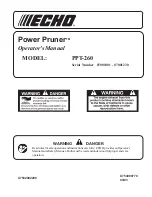
Before making a cut, be sure all adjustments are secure.
Be sure blade path is free of nails.
Inspect for and remove all nails from lumber before
cutting.
Never touch blade
or other moving parts during use.
Firmly mount the tool on a secure surface to ensure its stability before operating the
tool.
Never start a tool when any rotating component is in contact with the workpiece.
Do not operate a tool while under the influence of drugs, alcohol, or any medication.
When servicing use only identical replacement parts.
Use of any other parts may
create a hazard or cause product damage.
Use only recommended accessories
listed in this manual or addendums. Use of
accessories that are not listed may cause the risk of personal injury. Instructions for
safe use of accessories are included with the accessory.
Double check all setups.
Make sure blade is tight and not making contact with saw or
workpiece before connecting to power supply.
Do not allow familiarity
(gained from frequent use of your saw)
to cause a careless
mistake.
Always remember that a careless fraction of a second is sufficient to inflict
serious injury. Use extra caution and keep your attention on your operation when
making repetitive cuts. Reduce the monotony of operations by frequently taking
breaks, cleaning up saw dust, or checking the tool's condition.
Keep guards in place. Guards must be in working order and be properly mounted.
A
guard that is loose, damaged, or is not functioning correctly must be repaired or
replaced.
Always use saw blade guard, riving knife and anti-kickback device for every
through-cutting operation.
For through-cutting operations where the saw blade cuts
completely through the thickness of the workpiece, the guard and other safety devices
help reduce the risk of injury.
Immediately reattach the guarding system after completing an operation (such as
rabbeting, dadoing or resawing cuts) which requires removal of the guard, riving knife
and/or anti-kickback device.
The guard, riving knife, and anti-kickback device help to
reduce the risk of injury.
Make sure the saw blade is not contacting the guard, riving knife or the workpiece
before the switch is turned on.
Inadvertent contact of these items with the saw blade
could cause a hazardous condition.
Adjust the riving knife as described in this instruction manual.
Incorrect spacing,
positioning and alignment can make the riving knife ineffective in reducing the
likelihood of kickback.
SAFETY GUIDELINES
SAFETY GUIDELINES
Use the appropriate saw blade for the riving knife.
For the riving knife to function
properly, the saw blade diameter must match the appropriate riving knife and the
body of the saw blade must be thinner than the thickness of the riving knife and the
cutting width of the saw blade must be wider than the thickness of the riving knife.
Keep blades clean, sharp, and with sufficient set.
Sharp blades minimize stalling and
kickback.
Keep hands away from cutting area.
Keep hands away from blades. Do not reach
underneath work or around or over the blade while blade is rotating. Do not attempt
to remove cut material when blade is moving. The material may become trapped
between the fence or inside the saw blade guard and the saw blade pulling your
fingers into the saw blade. Turn the saw off and wait until the saw blade stops before
removing material.
Blade coasts after being turned off.
Never use in an explosive atmosphere.
Normal sparking of the motor could ignite
fumes.
Inspect tool cords periodically.
If damaged, have repaired by a qualified service
technician at an authorized service facility. The conductor with insulation having an
outer surface that is green with or without yellow stripes is the equipment-grounding
conductor. If repair or replacement of the electric cord or plug is necessary, do not
connect the equipment-grounding conductor to a live terminal. Repair or replace a
damaged or worn cord immediately. Stay constantly aware of cord location and keep
it well away from the rotating blade.
Inspect extension cords periodically
and replace if damaged.
Ground all tools.
If tool is equipped with three-prong plug, it should be plugged into a
three-hole electrical receptacle.
Check with a qualified electrician
or service personnel, if the grounding instructions
are not completely understood, or if in doubt as to whether the tool is properly
grounded.
Use only correct electrical devices:
3-wire extension cords that have 3-prong
grounding plugs and 3-hole receptacles that accept the tool's plug.
Do not modify
the plug provided. If it will not fit the outlet, have the proper outlet
installed by a qualied electrician.
Keep tool dry, clean, and free from oil and grease.
Always use a clean cloth when
cleaning. Never use brake fluids, gasoline, petroleum-based products, or any solvents
to clean tool.
Stay alert and exercise control.
Watch what you are doing and use common sense. Do
not operate tool when you are tired. Do not rush.
Do not use tool if switch does not turn it on and off.
Have defective switches replaced
by an authorized service centre.
Use only correct blades.
Do not use blades with incorrect size holes. Never use blade
washers or blade bolts that are defective or incorrect. The maximum blade capacity of
your saw is 10" (25.4 cm). Blades that do not match the mounting hardware of the saw
will run off-centre, causing loss of control.
13
12
model no. 055-9033-8 | contact us 1-800-689-9928
model no. 055-9033-8 | contact us 1-888-670-6682
•
•
•
•
•
•
•
•
•
•
•
•
•
•
•
•
•
•
•
•
•
•
•
•
•
Safety instructions for table saws
1) Guarding related warnings
•
•
•
•
•
Summary of Contents for 055-9033-8
Page 1: ......








































